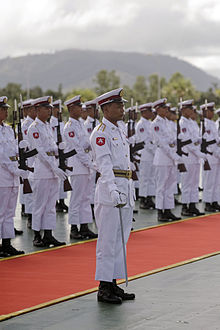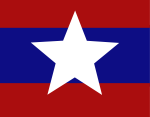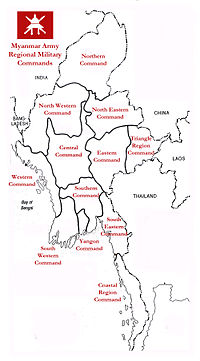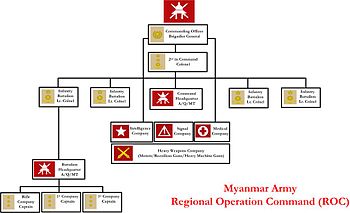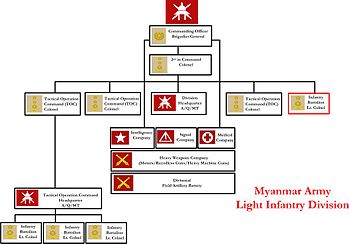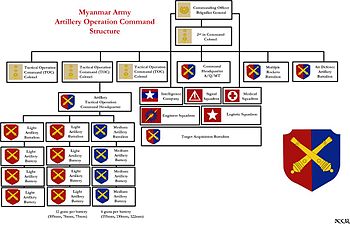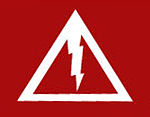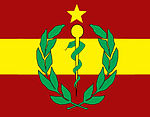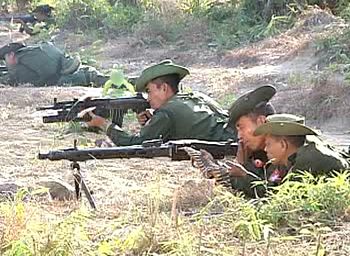- Myanmar Army
-
Myanmar Army
တပ်မတော်(ကြည်း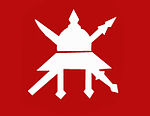
Myanmar Army FlagActive Country Myanmar Branch Army Size 350,000[1] Part of Myanmar Armed Forces Nickname Tatmadaw Motto Ye Thaw Ma Thay, Thay Thaw Nga Ye Ma Lar Anniversaries 27 March 1945 Commanders Minister of Defence [2] Major General Hla Min Commander in Chief of Myanmar Army Lt-General Soe Win Notable
commandersMajor General Aung San
General Ne WinThe Myanmar Army (Burmese: တပ်မတော်(ကြည်း)), pronounced [taʔmədɔ̀ tɕí]) is the land component of the Military of Myanmar. The Myanmar Army is the largest branch of the Armed Forces of Myanmar and has the primary responsibility of conducting land-based military operations. The Myanmar Army maintains the second largest active force in Southeast Asia after Vietnam's Vietnam People's Army.
The Myanmar Army has a troop strength around 492,000. The army has extensive combat experience in fighting insurgents in rough terrains, considering it has been conducting non-stop counter-insurgency operations against ethnic and political insurgents since its inception in 1948.
The force is headed by the Commander in Chief (Army), currently Lieutenant General Soe Win with General Min Aung Hlaing as the Commander in Chief. The highest rank in the Myanmar Army was Senior General, equivalent to Field Marshal position in Western Armies and was held by Senior General Than Shwe.
In 2011, following transition from military junta government to civilian parliamentary government, the Myanmar Army enacted a military draft for all citizens, all males from the age 18 to 35 and all females age between 18 and 27 years of age can be drafted into military service for two years as enlisted personal in time of national emergency. The ages for professionals are up to 45 for men and 35 for women for three years service as commissioned and non commissioned officers.
An official publication has revealed that almost one-quarter of Myanmar's new national budget will be allocated to defense. The Government Gazette reports that 1.8 trillion kyat (about $2 billion at free market rates of exchange), or 23.6 percent of the 2011 budget will go to defense.[3]
Brief history
Post Independence era
At the time of Myanmar's independence in 1948, the Tatmadaw was weak, small and disunited. Cracks appeared along the lines of ethnic background, political affiliation, organizational origin and different services. Its unity and operational efficiency was further weakened by the interference of civilians and politicians in military affairs, and the perception gap between the staff officers and field commanders. The most serious problem was the tension between ethnic Karen Officers, coming from the British Burma Army and Burman (Bamar) officers, coming from the Patriotic Burmese Force (PBF).[4]
In accordance with agreement reached at Kandy Conference in September 1945, the Tatmadaw was reorganised by incorporating the British Burma Army and the Patriotic Burmese Force. The officer corps shared by ex-PBF officers and officers from British Burma Army and Army of Burma Reserve Organization (ARBO). The British also decided to form what were known as "Class Battalions" based on ethnicity. There were a total of 15 rifle battalions at the time of independence and four of them were made up of former members of PBF. All influential positions within the War Office and commands were manned with non-former PBF Officers. All services including military engineers, supply and transport, ordnance and medical services, Navy and Air Force were all commanded by former Officers from ABRO and British Burma Army.[4]
Ethnic and Army Composition of Tatmadaw in 1948 Battalion Ethnic/Army Composition No. 1 Burma Rifles Bamar (Burma Military Police) No. 2 Burma Rifles Karen majority + Other Non-Bamar Nationalities No. 3 Burma Rifles Bamar / Former members of Patriotic Burmese Force No. 4 Burma Rifles Bamar / Former members of Patriotic Burmese Force - Commanded by the then Lieutenant Colonel Ne Win No. 5 Burma Rifles Bamar / Former members of Patriotic Burmese Force No. 6 Burma Rifles Bamar / Former members of Patriotic Burmese Force No. 1 Karen Rifles Karen / Former members of British Burma Army and ABRO No. 2 Karen Rifles Karen / Former members of British Burma Army and ABRO No. 3 Karen Rifles Karen / Former members of British Burma Army and ABRO No. 1 Kachin Rifles Kachin / Former members of British Burma Army and ABRO No. 2 Kachin Rifles Kachin / Former members of British Burma Army and ABRO No. 1 Chin Rifles Chin / Former members of British Burma Army and ABRO No. 2 Chin Rifles Chin / Former members of British Burma Army and ABRO No. 4 Burma Regiment Gorkha Chin Hill Battalion Chin Formation and structure
The Army has always been by far the largest service in Myanmar and has always received the lion's share of the defence budget.[5][6] It has played the most prominent part in Myanmar's struggle against the 40 or more insurgent groups since 1948 and acquired a reputation as a tough and resourceful military force. In 1981, it was described as 'probably the best army in Southeast Asia, apart from Vietnam's'.[7] The judgement was echoed in 1983, when another observer noted that "Myanmar's infantry is generally rated as one of the toughest, most combat seasoned in Southeast Asia".[8] In 1985, a foreign journalist with the rare experience of seeing Burmese soldiers in action against ethnic insurgents and narco-armies was 'thoroughly impressed by their fighting skills, endurance and discipline'.[9] Other commentators throughout that time characterised the Myanmar Army as 'the toughest, most effective light infantry jungle force now operating in Southeast Asia'.[10] Even the Thais, not known to praise the Burmese lightly, have described the Myanmar Army as 'skilled in the art of jungle warfare'.[11]
Organization
Myanmar Army had reached some 370,000 active troops in all ranks in the year 2000. There were 337 infantry battalions, including 266 light infantry battalions. Although the Myanmar Army's organisational structure was based upon the regimental system, the basic manoeuvre and fighting unit is the battalion, known as Tat Yinn in Burmese, which comprised a headquarters unit; four rifle companies (tat khwe) with three rifle platoons (Tat Su) each; an administration company with medical, transport, logistics and signals units; a heavy weapons company including mortar, machine gun and recoilless gun platoons. Each battalion is commanded a Lieutenant Colonel (du bo hmu gyi) with a Major (bo hmu) as 2IC (Second in Command), with a total establishment strength of 27 officers and 723 other ranks. Light infantry battalions in Myanmar Army have much lower establishment strength of around 500; this often leads to these units being mistakenly identified by the observers and reporters as under strength infantry battalions.
With its significantly increased personnel numbers, weaponry and mobility, today's Tatmadaw Kyee is a formidable conventional defence force for the Union of Myanmar. Troops ready for combat duty have at least doubled since 1988. Logistics infrastructure and Artillery Fire Support has been greatly increased. Its newly acquired military might was apparent in the Tatmadaw's dry season operations against Karen National Union (KNU) strongholds in Manerplaw and Kawmura. Most of the casualties at these battles were the result of intense and heavy bombardment by the Tatmadaw Kyee. Not only that Tatmadaw Kyee is now much larger than it was in pre-1988, it is more mobile and has greatly improved armour, artillery and air defence inventories. Its C3I (Command, Control, Communications, Computers and Intelligence) systems have been expanded and refined. It is developing larger and more integrated, self-sustained formations which should lend themselves to better coordinated action by different combat arms. The army may still have relatively modest weaponry compared to its larger neighbours, but it is now in a much better position to deter external aggression and respond to such a threat should it ever arise except child soldiers may not perform very well in combating with enemies.[12]
Expansion
The first army division to be formed after the 1988 military coup was the 11th Light Infantry Division (LID) in December 1988 with Col. Win Myint as commander of the division. In March 1990, a new regional military command was opened in Monywa with Brigadier Kyaw Min as commander and named North-Western Regional Military Command. A year later 101st LID was formed in Pakokku with Col. Saw Tun as commander. Two Regional Operations Commands (ROC) were formed in Myeik and Loikaw to facilitate command and control. They were commanded respectively by Brigadier Soe Tint and Brigadier Maung Kyi. March 1995 saw a dramatic expansion of the Tatmadaw as it established 11 Military Operations Commands (MOC)s in that month. MOC are similar to Mechanized Infantry Divisions in western armies, each with 10 regular infantry battalions (Chay Hlyin Tatyin), a headquarters, and organic support units including field artillery batteries. Then in 1996, two new RMC were opened, Coastal Region RMC was opened in Myeik with Brigadier Sit Maung as commander and Triangle Region RMC in Kengtung with Brigadier Thein Sein as commander. Their new ROCs were opened in Kalay, Bhamo and Mongsat. In late 1998, two new MOCs were opened in Bokepyin and Mongsat.[13]
The most significant expansion after the infantry in the army was in armour and artillery. Beginning in 1990, the Tatmadaw procured 18 T-69II Main Battle tanks and 48 T-63 amphibious light tanks from China. Further procurements were made, including several hundred Type 85 and Type 92 Armoured Personnel Carriers (APC). By the beginning of 1998, Tatmadaw had about 100+ T-69II Main battle tanks, a similar number of T-63 amphibious light tanks and several T-59D tanks. These tanks and armoured personnel carriers were distributed into five armoured infantry battalions and five tank battalions and formed the first Armoured Division of the Tatmadaw under the name of 71st Armoured Operations Command with its headquarters in Pyawbwe.
Chief of Staffs and Commander in Chiefs
Up until 1990, Myanmar Armed Forces has Chief of Staff system and Myanmar Army was led by Vice Chief of Staff (Army). A new system was introduced in 1990 during Armed Forces reorganisation and all three branches of Armed Forces are now led by Commander-in-Chief.[6]
Serial Name & Rank Date Notes BC5107 Brigadier General Saw Kyar Doe 1948 Karen Officer, Forced to retire due to civil war with Karen BC3502 Brigadier General Ne Win 1948–1949 Member of Thirty Comrades, Later became President and Chairman of Burma Socialist Programme Party (BSPP) BC5458 Brigadier General Aung Gyi 1956–1963 BC3569 Brigadier General San Yu 1963–1972 Later became President BC3651 Brigadier General Thura Tin Oo 1972–1974 Dismissed and imprisoned for involvement in coup attempt, later became Vice-Chairman of National League for Democracy BC5332 Brigadier General Thura Kyaw Htin 1974–1976 Later became Prime Minister BC6133 Lieutenant General Aye Ko 1976–1981 Later became Vice President BC5096 Lieutenant General Tun Ye 1981–1983 BC6187 Lieutenant General Saw Maung 1983–1985 later promoted to Senior General, coup in 1988 and formed States Law and Order Restoration Council (SLORC) BC6710 Lieutenant General Than Shwe 1985–1992 later promoted to Senior General and Chairman of State Peace and Development Council (SPDC) Lieutenant General Maung Aye 1993 - 31/3/2011 later promoted to Vice Senior General Lieutenant General Soe Win 1/4/2011- Bureau of Special Operations (BSO)
Bureau of Special Operations (ကာကွယ်ရေးဌာန စစ်ဆင်ရေး အထူးအဖွဲ့) in Myanmar Army are high-level field units equivalent to Field Army Group in Western terms and consist of 2 or more Regional Military Commands (RMC) and commanded by a Lieutenant-General and 6 staff officers. The units were introduced under the General Staff Office on 28 April 1978 and 1 June 1979. In early 1978, the then Chairman of BSPP General Ne Win visited the North Eastern Command Headquarters in Lashio to receive a briefing about Burmese Communist Party (BCP) insurgents and their military operations. He was accompanied by Brigadier General Tun Ye from Ministry of Defence. Brigadier General Tun Ye was the regional commander of Eastern Command for three years and before that he served in North Eastern Command areas as commander of Strategic Operation Command (SOC) and commander for Light Infantry Division for four years. As BCP military operations were spread across three Regional Military Command (RMC) areas (Northern, Eastern and North Eastern), Brigadier General Tun Ye was the most informed commander about the BCP in Myanmar Army at the time. At the briefing, General Ne Win was impressed by Brigadier General Tun Ye and realized that coordination among various Regional Military Commands (RMC) was necessary; thus, decided to form a bureau at the Ministry of Defence. Originally, the bureau was for "special operations", wherever they were, that needed coordination among various Regional Military Commands (RMC). Later, with introduction of another bureau, there was a division of command areas. The BSO-1 was to oversee the operations under the Northern Command, North Eastern Command, the Eastern Command, and the North Western Command. BSO-2 was to oversee operations under the South Eastern Command, South Western Command, Western Command and Central Command. Initially, the chief of the BSO had the rank of Brigadier General. The rank was upgraded to Major General on 23 April 1979. in 1990, it was further upgraded to Lieutenant General. Between 1995 and 2002, Chief of Staff (Army) jointly held the position of Chief of BSO. However, in early 2002, two more BSO were added to the General Staff Office; therefore there were altogether four BSOs. The fifth BSO was established in 2005 and the sixth in 2007.
Currently there are Six Bureaus of Special Operations in Myanmar order of Battle.[14]
Bureau of Special Operations Regional Military Commands (RMC) Bureau of Special Operations 1 Central Command
North Western Command
Northern CommandBureau of Special Operations 2 North Eastern Command
Eastern Command
Triangle Region CommandBureau of Special Operations 3 South Western Command
Southern Command
Western CommandBureau of Special Operations 4 Coastal Command
South Eastern CommandBureau of Special Operations 5 Yangon Command Bureau of Special Operations 6 Naypyidaw Command Regional Military Commands (RMC)
For better command and communication, the Tatmadaw formed Regional Military Commands (တိုင်း စစ်ဌာနချုပ်) structure in 1958. Until 1961, there were only two regional commands, they were supported by 13 Infantry brigades and an infantry division. In October 1961, new regional military commands were opened and leaving only two independent infantry brigades. In June 1963, the Naypyidaw Command was temporarily formed in Yangon with the deputy commander and some staff officers drawn from Central Command. It was reorganised and renamed as Yangon Command on 1 June 1965.[14]
A total of 337 infantry and light infantry battalions organised in Tactical Operations Commands, 37 independent field artillery regiments supported by affiliated support units including armoured reconnaissance and tank battalions. RMCs are similar to corps formations in Western armies. The RMCs, commanded by Major General rank officer, are managed through a framework of Bureau of Special Operations (BSOs), which are equivalent to Field Army Group in Western terms.[14]
Regional Military Command (RMC) Badge States & Divisions Headquarters Strength Northern Command (မြောက်ပိုင်းတိုင်းစစ်ဌာနချုပ်)

Kachin State Myitkyina 33 Infantry Battalions North Eastern Command (အရှေ့မြောက်ပိုင်းတိုင်း စစ်ဌာနချုပ်)

Northern Shan State Lashio 30 Infantry Battalions Eastern Command (အရှေ့ပိုင်းတိုင်းစစ်ဌာနချုပ်)

Southern Shan State Taunggyi 42 Infantry Battalions
including 16× Light Infantry Battalions under
Regional Operation Command (ROC) Headquarters at LoikawSouth Eastern Command (အရှေ့တောင်ပိုင်းတိုင်း စစ်ဌာနချုပ်)

Mon and Kayin (Karen) States Mawlamyaing (Moulmein) 36 Infantry Battalions Southern Command (တောင်ပိုင်းတိုင်း စစ်ဌာနချုပ်)

Bago and Magwe Divisions Toungoo 27 × Infantry Battalions South Western Command (အနောက်တောင်ပိုင်းတိုင်း စစ်ဌာနချုပ်)

Ayeyarwady Division (Irrawaddy Division) Pathein (Bassein) 11 × Infantry Battalions Western Command (အနောက်ပိုင်းတိုင်း စစ်ဌာနချုပ်)

Rakhine (Arakan) and Chin States Ann 33 × Infantry Battalions North Western Command (အနောက်မြောက်ပိုင်းတိုင်း စစ်ဌာနချုပ်)

Sagaing Division Monywa 25 × Infantry Battalions Yangon Command (ရန်ကုန်တိုင်း စစ်ဌာနချုပ်)

Yangon Division Mayangone Township-Kone-Myint-Thar 11 × Infantry Battalions Coastal Region Command (ကမ်းရိုးတန်းတိုင်း စစ်ဌာနချုပ်)

Tanintharyi Division (Tenassarim Division) Myeik (Mergui) 43 Infantry Battalions
including battalions under 2 MOC based at TavoyTriangle Region Command (တြိဂံတိုင်း စစ်ဌာနချုပ်)

Eastern Shan State Kyaingtong (Kengtung) 23 Infantry Battalions Central Command (အလယ်ပိုင်းတိုင်း စစ်ဌာနချုပ်)

Mandalay Division Mandalay 17 Infantry Battalions Naypyidaw Command (နေပြည်တော်တိုင်း စစ်ဌာနချုပ်)

Naypyidaw Pyinmana Formed in 2006 - ? × Infantry Battalions Commanders of Regional Military Commands
Regional Military Command (RMC) Established First Commander Current Commander Notes Naypyidaw Command 2005 Major General Maung Maung Aye Eastern Command 1961 Major General San Oo North Eastern Command 1972 Major General Aung Kyaw Zaw South Eastern Command 1961 Major General Htun Nay Lin Central Command 1961 Major General Ye Aung Original Southern Command in Taungoo was renamed Central Command in March, 1990 Western Command 1972 Major General Soe Thein North Western Command 1961 Brigadier General Kyaw Min Major General Soe Lwin Original North western Command in Mandalay was renamed Central Command in March, 1990 South Western Command 1961 Major General Tin Maung Win Northern Command 1972 Major General Zay Yar Aung Southern Command 1972 Major General Soe Htut Traingle Region Command 1996 Brigadier General Thein Sein Major General Than Tun Oo Thein Sein later became Prime Minister and elected as President in 2011 Coastal Region Command 1996 Brigadier General Thiha Thura Thura Sit Maung Major General Khin Maung Htay Sit Maung was killed in Helicopter crash along with the then Chief of Staff (Army) Lt. General Tin Oo in 19 Feb 2001.[15] Yangon Command 1965 Major General Tun Than Formed as Naypyidaw Command in 1963 with deputy commander and some staff officers from Central Command. Renamed Yangon Command on 1 June 1965. Regional Operations Commands (ROC)
Regional Operations Commands (ROC, or Da Ka Sa in Myanmar) are commanded by a Brigadier General, are similar to infantry brigades in Western Armies. Each consists of 4 Infantry battalions (Chay Hlyin Tatyin), HQ and organic support units. Commander of ROC is a position between LID/MOC commander and tactical Operation Command (TOC) commander, who commands only three infantry battalions. However, ROC commander enjoys financial, administrative and judicial authority while the MOC and LID commander does not have judicial authority.[6][16]
Regional Operation Command (ROC) Headquarters Notes Loikaw Regional Operations Command Loikaw Laukai Regional Operations Command Laukai Kalay Regional Operations Command Kalay Sittwe Regional Operations Command Sittwe Pyay Regional Operations Command Pyay Tanaing Regional Operations Command Tanaing Formerly ROC Bahmaw Wanhseng Regional Operations Command Wanhseng Formed in 2011 [17] Military Operations Commands (MOC)
Military Operations Commands (MOC) (စစ်ဆင်ရေး ကွပ်ကဲမှု စစ်ဌာနချုပ်), commanded by a Brigadier-General, are similar to Infantry divisions in Western Armies. Each consists of 10 Mechanized Infantry battalions equipped with BTR-3 Armored Personnel Carriers, Headquarters and support units including field artillery batteries. These ten battalions are organized into three Tactical Operations Commands : one Mechanized Tactical Operations Command (with BTR-3 armored personal carriers) and two Motorized Tactical Operations Command (with EQ-2102 6x6 trucks).
MOC are equivalent to Light Infantry Division (LID) in Myanmar Army order of battle as both command 10 infantry battalions through three TOC (Tactical Operations Command).[16]
Military Operation Command (MOC) Headquarters Notes 1st Military Operations Command (MOC-1) Kyaukme ကျောက်မဲ, Shan State 2nd Military Operations Command (MOC-2) Mong Nawng မိုင်း, Shan State 3rd Military Operations Command (MOC-3) Mogaung မိုးကောင်း, Kachin State 4th Military Operations Command (MOC-4) Hpugyi ဖူးကြီး, Yangon Region Designated Airborne Division 5th Military Operations Command (MOC-5) Taungup တောင်ကုတ်, Rakhine State 6th Military Operations Command (MOC-6) Pyinmana ပျဉ်းမနား, Mandalay Region 7th Military Operations Command (MOC-7) Hpegon ဖယ်ကုန်း, Shan State 8th Military Operations Command (MOC-8) Dawei ထားဝယ်, Tanintharyi Region 9th Military Operations Command (MOC-9) Kyauktaw ကျောက်တော်, Rakhine State 10th Military Operations Command (MOC-10) Kyigon ကြီးကုန်း, Sagaing Region 11th Military Operations Command (MOC-11) Loilem လွိုင်လင်, Shan State 12th Military Operations Command (MOC-12) Kawkareik ကော့ကရိတ်, Kayin State 13th Military Operations Command (MOC-13) Bokpyin ဘုတ်ပြင်း, Tanintharyi Region 14th Military Operations Command (MOC-14) Mong Hsat မိုင်းဆတ်, Shan State 15th Military Operations Command (MOC-15) Buthidaung ဘူးသီးတောင်, Rakhine State 16th Military Operations Command (MOC-16) Theinni သိန္နီ, Shan State 17th Military Operations Command (MOC-17) Mong Pan မိုင်းပန်, Shan State 18th Military Operations Command (MOC-18) Mong Hpayak မိုင်းဖြတ်, Shan State 19th Military Operations Command (MOC-19) Ye ရေး, Mon State 20th Military Operations Command (MOC-20) Kawthaung ကော့သောင်း, Tanintharyi Region 21st Military Operations Command (MOC-21) Bhamo ဗန်းမော်, Kachin State Light Infantry Divisions (LID)
Light Infantry Division (Chay Myan Tat Ma or Ta Ma Kha), commanded by a Brigadier-General, each with 10 Light Infantry Battalions organised under 3 Tactical Operations Commands, commanded by a Colonel, (3 battalions each and 1 reserve), 1 Field Artillery Battalion, 1 Armour Squadron and other support units.[6][16]
These divisions were first introduced to the Myanmar Army in 1966 as rapid reaction mobile forces for strike operations. 77th Light Infantry Division was formed on 6 June 1966, followed by 88th Light Infantry Division and 99th Light Infantry Division in the two following years. 77th LID was largely responsible for the defeat of the Communist forces of the CPB (Communist Party of Burma) based in the forested hills of the central Bago Yoma in the mid 1970s. Three more LIDs were raised in the latter half of 1970s (the 66th, 55th and 44th) with their headquarters at Pyay, Aungban and Thaton. They were followed by another two LIDs in the period prior to the 1988 military coup (the 33rd LID with headquarters at Sagaing and the 22nd LID with headquarters at Hpa-An). 11th LID was formed in December 1988 with headquarters at Inndine, Bago Division and 101st LID was formed in 1991 with its headquarters at Pakokku.[6][16]
Each LID, commanded by Brigadier General (Bo hmu gyoke) level officers, consists of 10 light infantry battalions specially trained in counter-insurgency, jungle warfare, "search and destroy" operations against ethnic insurgents and narcotics-based armies. These Battalions are organised under three Tactical Operations Commands (TOC; Nee byu har). Each TOC, commanded by a Colonel (Bo hmu gyi), is made up of three or more combat Battalions, with command and support elements similar to that of brigades in Western armies. One infantry battalion was held in reserve. As of 2000, all LID have their own organic Field Artillery units. For example, 314th Field Artillery Battery is now attached to 44th LID. Some of the LID battalions have been given Parachute and Air Borne Operations training and two of the LIDs have been converted to mechanised infantry formation with divisional artillery, armoured reconnaissance and tank battalions[6]
LIDs are considered to be a strategic asset of the Myanmar Army, and after the 1990 reorganisation and restructuring of the Tatmadaw command structure, they are now directly answerable to Chief of Staff (Army).[6][16]
Light Infantry Division (LID) Year formed Headquarters First Commander Current Commander Notes 1988 Inndine Col. Win Myint Formed after 1988 military coup. 1987 Hpa-An Col. Tin Hla Invovled in crackdown of unarmed protestors during 8.8.88 democracy uprising 1984 Sagaing Col. Kyaw Ba 1979 Thaton Col. Myat Thin 1980 Sagaing/Kalaw Col. Phone Myint 1976 Pyay Col. Taung Zar Khaing 1966 Hmawbi Col. Tint Swe 1967 Magway Col. Than Tin 1968 Meiktila Col. Kyaw Htin 1991 Pakokku Col. Saw Tun Units of 101st LID were deployed during the purge of Military Intelligence faction in 2004. Artillery and armoured units
Artillery and armoured units were not used in an independent role, but were deployed in support of the infantry by the Ministry of Defence as required. The Directorate of Artillery and Armour Corps was also divided into separate corps in 2001. A dramatic expansion of forces under these directorates followed with the equipment procured from China, Russia, Ukraine and India.[6] [16]
Directorate of Artillery
No. 1 Artillery Battalion was formed in 1952 with three artillery batteries under the Directorate of Artillery Corps. A further three artillery battalions were formed in the late 1952. This formation remained unchanged until 1988. Since 2000, the Directorate of Artillery Corps has overseen the expansion of Artillery Operations Commands(AOC) from two to 10. Tatmadaw's stated intention is to establish an organic Artillery Operations Command in each of the 12 Regional Military Command Headquarters. Each Artillery Operation Command is composed of the following:[14]
As of 2000, the Artillery wing of the Tatmadaw has about 60 Battalions and 37 independent Artillery companies/batteries attached to various Regional Military Commands (RMC), Light Infantry Divisions (LID), Military Operation Command (MOC) and Regional Operation Command (ROC)s. For example, 314th Field Artillery Battery is under 44th LID, 326 Field Artillery Battery is attached to 5th MOC, 074 Field Artillery Battery is under the command of ROC (Bhamo) and 076 Field Artillery Battery is under North-Eastern RMC. Twenty of these Artillery battalions are grouped under 707th Artillery Operation Command (AOC) headquarters in Kyaukpadaung and 808th Artillery Operation Command (AOC) headquarters in Oaktwin, near Taungoo. The remaining 30 battalions, including 7 Anti-Aircraft artillery battalions are under the Directorate of Artillery Corps.[6] [16]
Artillery Operations Command (AOC)
- HQ battalion
- 12 Artillery Battalions:
- 6 Light Field artillery battalion equipped with 105 mm, 76 mm, 75 mm howitzers, field guns and mountain guns,
- 3 Medium Field Artillery battalion equipped with 155 mm, 130 mm, 122 mm howitzers and field guns,
- 1 Multiple Rocket Launcher battalion equipped with 122 mm self propelled and towed launchers,
- 1 Air Defence Artillery battalion with 37 mm, 57 mm Anti-Aircraft guns or SA 18 IGLAs) man portable surface-to-air missiles and
- 1 target acquisition battalion.
- support units
Light field artillery battalions consists of 3 field artillery batteries with 36 field guns or howitzers (12 guns per battery). Medium artillery battalions consists of 3 medium artillery batteries of 18 field guns or howitzers (6 guns per one battery).[14] As of 2011, all field guns of Myanmar Artillery Corps are undergoing upgrade programs including GPS Fire Control Systems.
Artillery Operations Command (AOC) Headquarters Notes 505th Artillery Operations Command 606th Artillery Operations Command Thaton 707th Artillery Operations Command Kyaukpadaung 808th Artillery Operations Command Oktwin--Taungoo 909th Artillery Operations Command Mong Khon--Kengtung 901st Artillery Operations Command Baw-Net-Kyi--Bago 902nd Artillery Operations Command 903rd Artillery Operations Command Loilem 904th Artillery Operations Command Mohnyin 905th Artillery Operations Command Padein--Ngape Directorate of Armour
No.1 Armour Company and No.2 Armour Company was formed in July, 1950 under the Directorate of Armour and Artillery Corps with Sherman tanks, Stuart Light Tanks, Humber Amour Scout Cars, Ferret Armoured Cars and Univerl Bren Carriers. These two companies were merged on 1 November 1950 to become No. 1 Armour Battalion with Headquarter in Mingalardon. On 15 May 1952 No. Tank Battalion was formed with 25 Comet Tanks acquired from United Kingdom. The Armour Corps within Myanmar Army was the most neglected one for nearly thirty years since the Tatmadaw did not procure any new tanks or armour carriers since 1961.
Armoured divisions, known as Armoured Operations Command (AROC), under the command of Directorate of Armour Corps, were also expanded in number from one to two, each with ten armoured battalions (five Armoured battalions equipped with Main battle Tanks and five Mechanised Infantry battalions equipped with Infantry fighting vehicles and Armored personnel carriers). [16] In mid-2003, Tamadaw acquired 139+ T-72 Main battle Tanks from Ukraine and signed a contract to build and equip a factory in Myanmar to produce and assemble 1,000 BTR Armored personnel carriers in 2004.[18] In 2006, the Government of India transferred an unspecified number of T-55 Main battle Tanks that were being phased out from active service to Tatmadaw along with 105 mm Light Field Guns, armoured personnel carriers and indigenous HAL Light Attack Helicopters in return for Tatmadaw’s support and cooperation in flushing out Indian insurgent groups operating from its soil.[19]
Armoured Operations Command (AROC)
Armoured Operations Commands (AROC) are equivalent to Independent Armoured Divisions in western term. Currently there are 5 Armoured Operations Commands under Directorate of Armoured Corps in Tatmadaw order of battle. Tatmadaw planned to establish an AROC each in 7 Regional Military Commands.[14] Typical Armoured Division in Myanmar Army composed of Headquarter, Three Armored Tactical Operations Command - each with one Mechanized battalion equipped with 44 BMP-1 or MAV-1 Infantry Fighting Vehicles, Two Tanks Battalions equipped with 44 Main Battle Tanks each, one Armored Reconnaissance battalion equipped with 32 Type-63A Amphibious Light Tanks, one Field Artillery battalion and a Support battalion. Support battalion composed of an engineer squadron, two logistic squadrons and a signal company.[14]
Myanmar Army has taken delivery of 150 EE-9 Cascavels from Israeli army(?) surplus in 2005. Although EE 9 are armoured reconnaissance vehicle, Myanmar Army categorized them as light tank and deploys them in eastern Shan State and triangle regions near Thai-Myanmar border.
Bureau of Air Defense
The Air Defence Command was formed during the late 1990s but was not fully operational until late 1999. It was renamed Bureau of Air Defense in the early 2000s. In early 2000, Tatmadaw established Myanmar Integrated Air Defence System (MIADS) with help from Russia, Ukraine and China. It is a tri-service bureau with units from all three branches of Myanmar Armed Forces. All Air Defence assets except Anti-Aircraft Artillery within Tatmadaw arsenal are integrated into MIADS. AAA guns are mostly unguided and deploy to use in barrage-style firing against attacking aircraft. MIADS is directly answerable to Bureau of Air Defence under Ministry of Defence.[14]
In 2010, Myanmar Air Defense Command has completed installation of optical fiber communication network throughout the country. Those network are to be used for Air defense operations between Central Command HQ from capital & several air bases, early warning radar stations & mobile anti air craft missile & artillery units. After completion of fiber optic project & radar stations, MIADS (Myanmar Integrated Air Defense System) becomes the most advance AD system in the region.
Chief of Staff of Air Defence Years Notes Lt. General Soe Win 1997–2004 Later became Prime Minister Lt. General Myint Hlaing 2004–2010 Lt. General Sein Win 2010 - current Sector Operations Commands
Under MIADS, the country was divided into six Air Defense Sectors, each controlled by a Sector Operations Center (SOC) and reporting directly to the National Air Defense Operations Center (ADOC) in Yangon. Each SOC transmitted data back to Intercept Operations Centers (IOC), which in turn controlled SAM batteries and fighter/interceptor squadrons at various Air Bases. Each IOC was optimized to direct either SAMs or fighter/interceptor aircraft against incoming enemy aircraft or missile. Each IOC was connected to observer and early warning area reporting posts (RP) via military owned underground fibre optic cable network. There were about 100 radar stations located at approximately 40 sites throughout the country. New Air Defence radars such as 1L117 radars, Galaxy Early Warning Radar and P series radars are installed in all radar stations.[14]
Each Sector Operation Center (SOC) is commanded by a Major General and it consists of one air defense division from Myanmar Army and one fighter-interceptor wing from Myanmar Air Force. Sometimes Air Defense Frigates from Myanmar Navy also operates under the direct command of respective SOC.
Each Air Defense division is commanded by a Brigadier General and consists of three Air Defense Tactical Operations Command (TOC) and support units. One Medium Range Surface to Air Missile Tactical Operations Command (MRSAM-TOC), with three battalions equipped with Buk M-1 or Kub missile system is deployed in an Area Defense Belt role. One Short Range Air Defense Tactical Operations Command (SHORAD-TOC), with three battalions equipped with Tor M-1 missile system is deployed in a Point Defense role for critical areas such as radar stations, fighter bases and SOC headquarters. One Electronic Reconnaissance Tactical Operations Command (EIR-TOC) with 6 to 8 radar and communication companies for early warnings and interdiction detection.
Each fighter-interceptor wing commanded by a Brigadier General and is composed of three Fighter squadrons of either MiG-29 and F-7M Airguard Interceptors (ten air crafts per squadron) and their ground base support units.[14]
Sector Operation Centers Headquarters Notes Northern SOC Myitkyina Southern SOC Myeik Western SOC Sittwe Eastern SOC Tachilek South Eastern SOC Yay Central SOC Meiktila Directorate of Signal
Soon after the independence in 1948, Myanmar Signal Corps was formed with units from Burma Signals, also known as "X" Branch. It consisted HQ Burma Signals, Burma Signal Training Squadron (BSTS) and Burma Signals Squadron. HQ Burma Signals was located within War Office. BSTS based in Pyain Oo Lwin was formed with Operating Cipher Training Troop, Dispacth Rider Training Troop, Lineman Training Troop, Radio Mechanic Training Troop and Regimental Signals Training Troop. BSS, based in Mingalardon, had nince sections: Administration Troop, Maintenance Troop, Operating Troop, Cipher Troop, Lineman and Dispatch Rider Troop, NBSD Singals Troop, SBSD Signals Troop, Mobile Brigade Singals Toop and Arakan Singals Toop. The then Chief of Signal Staff Officer (CSO) was Lieutenant Colonel Saw Aung Din. BSTS and BSS were later renamed No. 1 Signal Battalion and No.1 Signal Training Battalion. In 1952, the Infantry Divisional Signals Regiment was formed and later renamed to No. 2 Signal Battalion. HQ Burma Signals was reorganised and became Directorate Signal and the director was elevated to the rank of Colonel. In 1956, No. 1 Signal Security Battalion was formed, followed by No. 3 Signal Battalion in November 1958 and No.4 Signal Battalion in October 1959.
In 1961, signal battalions were reorganised as No. 11 Signal Battalion under North Eastern Regional Military Command, No. 121 Signal Battalion under Eastern Command, No. 313 Signal Battalion under Central Command, No.414 Signal Battalion under South Western Command, and No. 515 Signal Battalion under South Eastern Command. No.1 Signal Training Battalion was renamed Burma Signal Training Depot (Baho-Setthweye-Tat).
By 1988, Directorate of Signals command one training depot, eight signal battalions, one signal security battalion, one signal store depot and two signal workshops. Siganl Corps under Directorate of Signal further expanded during 1990 expansion and reorganisation of Myanmar Armed Forces. By 2000, a signal battalion is attached to each Regional Military Command and signal companies are now attached to Light Infantry Divisions and Military Operations Commands.
In 2000, Command, Control and Communication system of Myanmar Army has been substantially upgraded by setting up the military fibre optic communication network managed by Directorate of Signal throughout the country. Since 2002 all Myanmar Army Regional Military Command HQs used its own telecommunication system. Satellite communication links are also provided to forward-deployed infantry battalions. However, battle field communication systems are still poor. Infantry units are still using TRA 906 and PRM 4051 which were acquired from UK in 1980s. Myanmar Army also uses Thura (locally built TRA 906) and XD-D6M (Chinese) radio sets. Frequency hopping handsets are fitted to all front line units.[20]
Between 2000 to 2005, Myanmar army bought 50 units of Brett 2050 Advanced Tech radio set from Aussie through third party from Singapore. Those units are distributed to ROCs in central & upper regions to use in counterinsurgency operations. [14][16]
Directorate of Medical Services
Main article: Directorate of Medical ServicesAt the time of independence in 1948, the medical corps has two Base Military Hospitals, each with 300 beds, in Mingalardon and Pyin Oo Lwin, a Medical Store Depot in Yangon, a Dental Unit and six Camp Reception Stations located in Myitkyina, Sittwe, Taungoo, Pyinmana, Bago and Meikhtila. Between 1958 and 1962, the medical corps was restructred and all Camp Reception Stations were reorganised into Medical Battalions.
In 19889, Directorate of Medical Services has significantly expanded along with the infantry. In 2007, there are two 1,000 bed Defence Services General Hospitals (Mingalardon and Naypyitaw), two 700-bed hospitals in Pyin Oo Lwin and Aung Ban, two 500 bed military hospitals in Meikhtila and Yangon, one 500 bed Defence Services Orthopedic Hospital in Mingalardon, two 300 bed Defence Services Obstetric, Gynecological and Children hospital (Mingalardon and Naypyitaw), three 300 bed Military Hospital (Myitkyina, Ann and Kengtung), eighteen 100 bed Military Hospitals (Mongphyet, Baan, Indaing, Bahtoo, Myeik, Pyay, Loikaw, Namsam, Lashio, Kalay, Mongsat, Dawai, Kawthaung, Laukai, Thandaung, Magway, Sittwe, and Hommalin), fourteen field medical battalions, which are attached to various Regional Military Commands throughout the country. Each Field Medical Battalion consist of 3 Field Medical Companies with 3 Field Hospital Units and a specialist team each. Health & Disease Control Unit (HDCU) is responsible for prevention, control & eradication of diseases.
Units Headquarter RMC Medical Corps Centre Hmawbi Yangon Command No.(1) Field Medical Battalion Mandalay Central Command No.(2) Field Medical Battalion Taunggyi Eastern Command No.(3) Field Medical Battalion Taungoo Southern Command No.(4) Field Medical Battalion Pathein South Western Command No.(5) Field Medical Battalion Mawlamyaing South Eastern Command No.(6) Field Medical Battalion Hmawbi Yangon Command No.(7) Field Medical Battalion Monywa North Western Command No.(8) Field Medical Battalion Sittwe Western Command No.(9) Field Medical Battalion Mohnyin Northern Command No.(10) Field Medical Battalion Lashio North Eastern Command No.(11) Field Medical Battalion Bhamo Northern Command No.(12) Field Medical Battalion Kengtung Triangle Region Command No.(13) Field Medical Battalion Myeik Costal Region Command No.(14) Field Medical Battalion Taikkyi Yangon Command Health and Disease Control Unit Mingaladon Yangon Command Training
- See: Military Training in Myanmar
Defence academies and colleges
Flags Academies Locations 
National Defence College - NDC Naypyidaw 
Defence Services Command and General Staff College - DSCGSC Kalaw 
Defence Services Academy - DSA Pyin U Lwin 
Defence Services Technological Academy - DSTA Pyin U Lwin 
Defence Services Medical Academy - DSMA Yangon 
Defence Services Institute of Nursing and Paramedical Science - DSINP Yangon 
Defence Services Technological College - DSTC Hopong Training schools
Training Schools Locations Badge Officer Training School - OTS Fort Ba Htoo 
Basic Army Combat Training School Fort Ba Htoo 
1st Army Combat Forces School Fort Ba Htoo 
2nd Army Combat Forces School Fort Bayinnaung Artillery Training School Mone Tai 
Armour Training School Maing Maw Electronic Warfare School Pyin U Lwin Engineer School Pyin U Lwin Information Warfare School Yangon Air, Land and Paratroops Training School Hmawbi 
Special Forces School Fort Ye Mon Ranks and insignia
- See: Army ranks and insignia of Myanmar
The various rank of the Myanmar Army are listed below in descending order:[14]
Commissioned officers
Note: Senior General (OF-10) and Vice Senior General rank are currently inactive . General is now the highest rank in Myanmar Armed Forces and Lieutenant General in Army, Navy, Air Force, Bureau of Air Defense, Chief of Staff, Adjutant General, Quartermaster General and Bureau of Special Operations.
Myanmar Armed Forces Myanmar title ဗိုလ်ချုပ်မှူးကြီး ဒုတိယ ဗိုလ်ချုပ်မှူးကြီး ဗိုလ်ချုပ်ကြီး ဒုတိယ ဗိုလ်ချုပ်ကြီး ဗိုလ်ချုပ် ဗိုလ်မှူးချုပ် MLC TS Bo Gyoke Hmu Gyi Du Bo Gyoke Hmu Gyi Bo Gyoke Kyee Du Bo Gyoke Kyee Bo Gyoke Bo Hmu Gyoke Abbreviation - ဒုဗခမက ဗခက ဒုဗခက ဗခ ဗမခ Western Version Senior General Vice Senior General General Lieutenant General Major General Brigadier General UK equivalent Field Marshal nil General Lieutenant General Major General Brigadier NATO Code OF-10 OF-9 OF-8 OF-7 OF-6 Myanmar Armed Forces Myanmar title ဗိုလ်မှူးကြီး ဒုတိယ ဗိုလ်မှူးကြီး ဗိုလ်မှူး ဗိုလ်ကြီး ဗိုလ္ ဒုတိယ ဗိုလ္ MLC TS Bo Hmu Gyi Du Bo Hmu Gyi Bo Hmu Bo Gyi Bo Du Bo Abbreviation ဗမက ဒုဗမက ဗမ ဗက ဗ ဒုဗ Western Version Colonel Lieutenant Colonel Major Captain Lieutenant Second Lieutenant UK equivalent Colonel Lieutenant Colonel Major Captain Lieutenant Second Lieutenant NATO Code OF-5 OF-4 OF-3 OF-2 OF-1 Non-Commissioned Officers (NCOs)
Non-Commissioned Officers are referred to as Saya, meaning Teacher, by both enlisted men and officers. For example, Warrant Officers, Regimental Sergeant Majors and Master Sergeant are referred to as Sayagyi, literally meaning "Old Teacher", Sergeant are referred to as Saya and Corporal/Lance Corporal as Sayalay. These unofficial ranks are used throughout the daily life of all branches. Non-Commissioned Officers (NCO) within the Myanmar Armed Forces are usually seasoned veteran soldiers. Thus both Officers and enlisted men refer to them as "teacher" out of respect.
Myanmar Armed Forces Myanmar title အရာခံဗိုလ် ဒုအရာခံဗိုလ် တပ်ခွဲတပ်ကြပ်ကြီး တပ်ကြပ်ကြီး တပ်ကြပ် ဒုတပ်ကြပ် MLC TS Ayagan Bo Du-Ayagan Bo Tatkhwè Tatkyatkyi Tatkyatkyi Tatkyat Du-Tatkyat Western Version Warrant Officer Regimental Sergeant Major Master Sergeant Sergeant Corporal Lance Corporal UK equivalent Warrant Officer Class One Warrant Officer Class Two Staff Sergeant Sergeant Corporal Lance Corporal Order of battle
- 13 x Regional Military Commands (RMC) organised in 6 Bureau of Special Operations (BSO)
- 6 x Regional Operations Commands (ROC)
- 20 × Military Operations Commands (MOC) including 1 x Airborne Infantry Division
- 10 x Light Infantry Divisions (LID)
- 10 x Armoured Operation Commands (AOC) (Each with 6 Tank Battalions and 4 Armoured Infantry Battalions (IFVs/APCs).)
- 10 x Artillery Operation Commands (AOC) (with of 113 Field Artillery Battalions)
- 6 x Anti-Aircraft Artillery/Air Defence Division (Each with 3 × Medium Range SAM Battalions, 3 × Short Range SAM Battalions, 3 × AAA/AD Battalion)
- 40+ Military Affair Security Companies (MAS Units replaces former Military Intelligence Units after the disbandment of the Directorate of Defense Service Intelligence (DDSI))
- 45 Advanced Signal Battalions
- 54 Field Engineer Battalions
- 4 Armoured Engineer Battalions
- 14 Medical Battalions
Equipment
Combat vehicles
Model Type Quantity Origin Notes T-55 Main battle tank 368[22][23]  Soviet Union
Soviet UnionAcquired from India. Type 59 Main battle tank 160+[24]  China
ChinaT-72 Main battle tank 139[25]  Soviet Union
Soviet UnionPurchased from Ukraine. Other reports claim as few as 14 purchased.[22] Type 69-II[26] Main battle tank 260[22]  China
ChinaType 88 (tank) Main battle tank 230  China
ChinaType 63[26] Light tank 150[26]  China
ChinaComet tank Light Tank 25  United Kingdom
United KingdomWWII Vintage EE-9 Cascavel Armoured Car 150  Brazil
Brazildelivered by Israel Panhard AML90 Armoured Car 50+  France
FranceDelivered by Israel Type 90 AFV Armoured Fighting Vehicle 55[27]  China
ChinaBMP-1 Infantry fighting vehicle 50  Soviet Union
Soviet Unionbrought from china [28] Type 85 Armoured fighting vehicle 250  China
ChinaType 85 AFV#Operators BTR-3U[29][30] Armoured personnel carrier 210 ordered (1,000)  Ukraine
UkrainePurchased as kits to be assembled locally until 2013 to circumvent embargo. MPV Armoured personnel carrier 10[22]  India
IndiaMine protected armoured personnel carrier. BAAC-87 APC Armoured personnel carrier 25  Myanmar
MyanmarBAAC-83 APC Armoured personnel carrier 11  Myanmar
MyanmarBAAC-73 SC Armoured car 20  Myanmar
MyanmarBAAC-84/85/86 SC Armoured car 30  Myanmar
MyanmarDingo Scout Car Armoured personnel carrier 72  United Kingdom
United KingdomWWII vintage Ferret Scout Car Armoured personnel carrier 6  United Kingdom
United KingdomWWII vintage Universal Carrier Armoured personnel carrier 80  United Kingdom
United KingdomWWII vintage Humber Pig Armoured personnel carrier 60  United Kingdom
United KingdomWWII vintage Artillery
Type Origin Quantity Notes Self-propelled artillery SH 1[31]  China
China150 155mm self-propelled howitzer Nora B-52[32]  Serbia
Serbia30 155 mm self-propelled howitzer Towed artillery D-30M  Soviet Union
Soviet Union270 122 mm howitzer D-20  Soviet Union
Soviet Union35 delivered in 2009 from DPRK. KH-179  South Korea
South Korea100+ 155 mm howitzer M48 mountain gun  Yugoslavia
Yugoslavia100 76 mm mountain gun Issued to the Airborne Division (4 MOC ) M-845P  Israel
Israel16 155 mm howitzer Soltam M-68  Israel
Israel? 155 mm 33 calibre towed gun howitzer Soltam M-71  Israel
Israel? 155 mm 39 calibre towed howitzer Ordnance QF 25 pounder  United Kingdom
United Kingdom50 World War II vintage 87.6 mm howitzer . Primarily used as a training weapon Ordnance QF 75 mm  United Kingdom
United Kingdom80 World War II vintage 122 mm howitzer BL 5.5 inch Medium Gun  United Kingdom
United Kingdom230 World War II vintage 140 mm howitzer Type 59-1  China
China160 130 mm field gun Various 105 mm howitzers Various 340+ Types: L118, M101, M56 and others . Most of them are locally manufactured MH-1 (version of L118 Light Gun) Multiple rocket launchers M-1991  Democratic People's Republic of Korea
Democratic People's Republic of Korea90 240 mm multiple rocket launcher (self-propelled) Type 90B  China
China90 122 mm multiple rocket launcher (self-propelled) Type 90  China
China90 122 mm multiple rocket launcher (self-propelled) BM-21  Soviet Union
Soviet Union230 122 mm multiple rocket launcher (self-propelled) BM-27  Soviet Union
Soviet Union35 220mm Multiple Rocket Launcher Type 63  China
China48 107 mm multiple rocket launcher (towed) BA-84  Myanmar
Myanmar72 122 mm multiple rocket launcher (towed) Air Defence
Type Origin Quantity Notes Missile systems BAe Dynamics Bloodhound Mk.II[6][33][34]  United Kingdom
United Kingdom60 Supplied by Singapore S-75 Dvina (SA-2 Guideline)  Soviet Union (
Soviet Union ( Russia)
Russia)250 Long-range surface-to-air missile system S-125 Neva/Pechora (SA-3 Goa)  Soviet Union (
Soviet Union ( Russia)
Russia)26 Long-range surface-to-air missile system S-200 Angara/Vega/DubnaSA-5 Gammon  Soviet Union (
Soviet Union ( Russia)
Russia)20 Long-range surface-to-air missile system 2K12 Kub (SA-6 Gainful)  Soviet Union (
Soviet Union ( Russia)
Russia)60 Self-propelled, medium-range surface-to-air missile system 9K37 Buk-M1-2 (SA-11 Gadfly)[34]  Soviet Union (
Soviet Union ( Russia)
Russia)60 Self-propelled, medium-range surface-to-air missile system 9K331M Tor-M1 (SA-15 Gauntlet)[34]  Soviet Union (
Soviet Union ( Russia)
Russia)122 Self-propelled, short-range surface-to-air missile system 2K22 Tunguska M-1 (SA-19 Grison)[34]  Soviet Union (
Soviet Union ( Russia)
Russia)70 Self-propelled, short-range surface-to-air gun and missile system 9K38 Igla (SA-18 Grouse)  Soviet Union (
Soviet Union ( Russia)
Russia)400 Very short-range portable surface-to-air missile system (MANPADS) CPMIEC HN5  China
China200 Very short-range portable surface-to-air missile system (MANPADS) Gun systems Type 56  China
China580 14.5 mm heavy machine gun in quadruple mounts Type-95 (anti-aircraft system) Various anti-aircraft guns 600 37 mm /40 mm /57 mm ZU-23-2 Type-87 (anti-aircraft system)  Soviet Union
Soviet Union380 Towed 23 mm anti-aircraft twin autocannon Bofors 40 mm  Sweden
Swedenunknown 40 mm anti-aircraft autocannon Support weapons
In Myanmar Army, Support Weapons are usually issued in Three different levels, for example, 60mm BA-100 mortar at Company level, 81mm BA-90 Mortar at battalion level and 120mm MA-6 Mortar at Tactical Operations Command (TOC) level.
Another example is Rocket and Grenade Launchers. MA-4 Assault Rifle with M-203 40mm Grenade Launcher are issued at Squad level, MA-10 Rocket Launcher, locally manufactured version of RPG-7, are issued at Company level and 84mm MA-14 Recoilless Gun, locally manufactured version of Carl Gustav M-2, at battalion level.
Type Origin Quantity Notes Mortars Various mortars Various 2400+ 60 mm (BA 100) / 81 mm (BA-90) / 120 mm (MA-6) Rocket Launchers and Recoilless Guns M-18 N/A 57 mm Type 36  China
ChinaN/A 57 mm M-20 Super Bazooka  United States
United States200 75 mm / 3.5 inch Type 52 Rocket Launchers  China
ChinaN/A 75 mm Type 56 Rocket Laungers  China
ChinaN/A 75 mm Type 65  China
ChinaN/A 82 mm Type 78  China
ChinaN/A 82 mm Carl Gustav M-2  Sweden
Sweden1800 84 mm (locally manufactured as MA-14) M40 recoilless rifle  United States
United StatesN/A 106 mm Heavy Machine guns 0.50 Cal. Browning M2HB Heavy Machine Gun  United States
United StatesN/A 0.5 Calibre 12.7mm NSV Heavy Machine Gun  Russia
RussiaN/A 12.7mm Type 85 Heavy Machine Gun  China
ChinaN/A 20mm Hispano Suiza Mk 5 Automatic Cannon  Sweden
SwedenN/A General Purpose Machine Guns/Light Machine Guns (GPMG/LMG)
The typical section support weapon before 1988 Tatmadaw modernization program was the locally manufactured 7.62 mm BA64 Light Machine Gun (LMG). This was essentially the G3 assault rifle fitted with heavy barrel, bi-pod and carrying handle. The G4 replaced the British 0.30in Bren LMG. Company fire support generally consisted of German-designed 7.62 mm MG3 General-purpose machine guns (made in Myanmar's own Ka Pa Sa factories) and the Belgian 7.62 mm FN MAG GPMG.
After modernization program, General Purpose Machine Guns and Light Machine Guns are distributed as follow: MA-2 5.56mm Light Machine Gun for Squad Fire Support, MA- 15 7.62 mm General Purpose Machine Gun, locally manufactured version of German MG3 in Company machine gun platoon and 12.7mm Type 85 Heavy Machine Gun or 0.50 Cal. Browning M2HB in battalion heavy weapon company.
Type Origin Calibre Notes Browning M1919A4  Belgium
Belgium.30 calibre Supplied by USA through Military Assistance Programme during the 70s Bren LMG  United Kingdom
United Kingdom.303 British World War II vintage, phased out from active units and transferred to Myanmar Police Force battalions and People Militia units Bren L4A4 LMG  United Kingdom
United Kingdom7.62 x 51 mm NATO phased out from active units and transferred to Myanmar Police Force battalions and People Militia units BA-64  Myanmar
Myanmar7.62 x 51 mm NATO Locally manufactured Light Machine Gun version of German G3 equipped with heavy barrel, bi-pod and carrying handle MA-2  Myanmar
Myanmar5.56 x 45 mm NATO Locally manufactured Light Machine Gun version of IMI Galil ARM equipped with heavy barrel, folding bi-pod, carrying handle and wooden hand guard. Standard issued Squad Fire Support MA15  Myanmar
Myanmar7.62 x 51 mm NATO Locally manufactured German MG3 General Purpose Machine Gun, Standard issued Company Fire Support FN MAG  Belgium
Belgium7.62 x 51 mm NATO Individual weapons
Before 1988, the standard Myanmar infantry weapon was the 7.62 mm BA-63 Assault Rifle, a locally produced version of the Heckler & Koch G3. Myanmar also produced a shorter, lighter carbine version of the same rifle under the designation BA-72, simply known as the G2 and Light machine gun variant, known as BA-64 or G4, equipped with heavy barrel, folding bipod, and carrying handle. A fourth version of the G3 with integral scope attached, known as the BA-100, was more accurate and reliable, but was primarily used as a sniper's weapon.
Many soldiers, mainly officers and NCO, still carried 0.30 caliber M1 and M2 carbines provided by the US in the 1950s under the Military Assistance Program (MAP). These world war two vintage carbines are ideal for jungle warfare.[citation needed]
From the beginning of 2002, 7.62 mm BA series assault rifles have been gradually replaced by 5.56x45mm NATO MA-series assault rifles in Myanmar Army's front line units, tested earlier as the EMERK-3.[35] MA-series assault rifles are identical to Israeli GALIL rifle family and fire 5.56x45mm NATO NATO rounds. From the beginning of 2011, Myanmar Army start producing so many Heckler & Koch HK33 assault rifles for Myanmar Army's front line units, as MA-12.
As side-arm, officers used the 9mm SIG Sauer P226 semi-automatic pistol locally manufactured under license as MA-6.
Type Origin Calibre Notes Assault Rifles MA-1 Assault rifle  Myanmar
Myanmar5.56x45mm NATO Locally manufactured version of IMI Galil Assault Rifle with wooden hand-guard and butt-stock, standard issue and replaced older BA-62 rifles. Heckler & Koch HK33 Assault rifle  Myanmar
Myanmar5.56x45mm NATO Locally manufactured version of Heckler & Koch HK33 Assault Rifle, standard issue and replaced older MA series rifles in 2010. MA-3 Assault Carbine  Myanmar
Myanmar5.56x45mm NATO Locally manufactured version of IMI Galil SAR Carbine with folding metal stock and shorter barrel (13.1 in) - standard issue carbine for officers and squad/platoon commanders. Replaced M1 and M2 carbines MA-4 Assault Rifle  Myanmar
Myanmar5.56x45mm NATO Locally manufactured version of IMI Galil AR with 40mm M203 Grenade Launcher MA-11 Assault Rifle  Myanmar
Myanmar5.56x45mm NATO Locally manufactured version of Heckler & Koch G3 chambered for 5.56x45mm NATO rounds with STANAG magazine as part of 5.56x45mm NATO round standardization. Most observers often mistake this as HK33 MA-12 Light Machine Gun  Myanmar
Myanmar5.56x45mm NATO Locally manufactured version of Heckler & Koch G3 chambered for 5.56x45mm NATO rounds with STANAG magazine. This is a Light Machine Gun variant with folding bi-pod and carrying handle. Most observers often mistake this as HK33 BA-63 Assault Rifle  Myanmar
Myanmar7.62x51mm NATO Locally manufactured version of HK-G3A2. Replaced by MA series assault rifles in active units, transferred to Myanmar Police Force battalions and People Militia units BA-64 Light Machine Gun  Myanmar
Myanmar7.62x51mm NATO Locally manufactured version Light Machine Gun of HK-G3 equipped with heavy barrel, folding bi-pod and carrying handle. Replaced by MA series assault rifles in active units, transferred to Myanmar Police Force battalions and People Militia units BA-72 Assault Rifle  Myanmar
Myanmar7.62x51mm NATO Locally manufactured carbine version of HK-G3K with shorter barrel. Replaced by MA series assault rifles in active units, transferred to Myanmar Police Force battalions and People Militia units BA-100 Assault Rifle  Myanmar
Myanmar7.62x51mm NATO Locally manufactured version of HK-G3A3ZF, Replaced by MA series assault rifles in active units, transferred to Myanmar Police Force battalions and People Militia units Type 81  China
China7.62x39mm Captured stock from Ethnic Insurgents and Narco Armies Type 56  China
China7.62x39mm Captured stock from Ethnic Insurgents and Narco Armies Kalashnikov AK-74  Russia
Russia5.45x39mm Captured stock from Ethnic Insurgents and Narco Armies Kalashnikov AKM  Russia
Russia7.62x39mm Captured stock from Ethnic Insurgents and Narco Armies 5.45 mm AKS-74U  Russia
Russia5.45x39mm Captured stock from Ethnic Insurgents and Narco Armies Sub-machine guns BA-52  Myanmar
Myanmar9mm Locally manufactured version of TZ-45 Sub-Machine Gun, famously known as "Ne Win Sten", phased out from active front line units and handed over to Myanmar Police Force and People Militia units. Heckler & Koch MP5  Myanmar
Myanmar9mm Locally manufactured version of Heckler & Koch MP5 Sub-Machine Gun. BA-94 / MA-13  Myanmar
Myanmar9mm Locally manufactured version of Uzi with wooden hand-guard and butt-stock. Mainly equipped to Body Guard Units and Special Force units. Sten / Sterling L2A3  United Kingdom
United Kingdom9mm Grenade Launchers Type 56 RPG / RPG2  China
China82mm War Head Type 69 RPG / RPG7  China
China85mm War Head locally manufactured as MA-10 GP-25  Russia
Russia40mm Captured stock from Ethnic Insurgents and Narco Armies M79  United States
United States40mm M203  United States
United States40mm Unlicensed local manufactured version for MA series assault rifles. Side Arm SIG Sauer P226  Myanmar
Myanmar9mm Locally manufactured version of 9mm SIG Sauer P226 pistol. Start using from 2011. Locally named as MA-6. Transport
Before 1988, Myanmar Army had less than 2,000 military trucks in their inventory, bulk of them are locally assembled 6 ton 4x2 Hino TE 11/21 trucks, and they had to rely on civil transport systems. After the 1988 military coup, with the starting of the defence modernization programme, Myanmar started to acquire hundreds of logistic vehicle mainly from China. In 1992, Myanmar Army bought 4,000 6 ton 4x2 FAW and Dongfeng EQ1093 trucks form China and delivery completed in 1995. However due to maintenance problems with the earlier TE 11 and 21, Myanmar Army again signed contract with China to buy 4,000 Jiefang CA1091 4x2 5 ton trucks.
Again in 1997, Myanmar Army acquired 1,000 Dongfeng EQ2102 3.5 tonne 6X6 military utility trucks and 200 Shaanqi SX 2190 6X6 military utility trucks for newly formed artillery units for towing guns. However during border clashes with neighbouring Thailand in 2002, Myanmar Army found difficulties with the existing 4x2 military trucks and then they acquired 3,000 Dongfeng EQ2102 3.5 tonne 6X6 military utility trucks. These trucks were delivered at China-Myanmar border town of Shwe Li between 2003 and 2006. In 2007 November, China has agreed to supply another 1,500 EQ2102 3.5 tonne 6x6 military utility trucks to Myanmar Military. As part of that agreement Myanmar has taken delivery of first batch of 350 EQ 2102 trucks in 2008 April and 650 trucks are to deliver in June.
Myanmar ordinance factories started assembling Chinese Aeolus 4x2 6 tonne military utility trucks in 1997. Myanmar Army is now believed to be operating more than 6,000 Aeolus trucks.
Unarmored vehicles
Type Origin Quantity Notes Trucks Hino Motors TE 11/21 [31] 
1,000 Now being phased out Jiefang Motors EQ1093 truck[32]  China
China4,000 4x2 5ton trucks Jiefang Motors EQ1091 truck  China
China4,000 4x2 5ton trucks Aeolus  Myanmar
Myanmar6,000 4x2 5 ton trucks Jiefang Motors EQ2102  China
China6,000 6x6 3.5 ton truck Shaanqi Motors SX 2190  China
China200 6x6 3.5 ton trucks FSC Star 266  Poland
Poland6x6 6 ton FAW CA6110  China
China6x6 6ton Utility Toyota Land Cruiser 
issued for Generals officers (OF-6 and above) Toyota Tiger Double Cub 
issued for colonels (OF-4 and OF-5) grand tiger Template:Country data myanmar 3,000 Used by Infantry Regiment for their front line logistic Isuzu Trooper 
2,000 Used by LIDs for their front line logistic Jiefang Motors Langian 
Urban utility vehicles (non-combative) Chin Dwin Star 
High Mobility Vehicle (locally reverse engineered AMC Hummer) See also
- Aung San
- Tatmadaw
- Myanmar Navy
- Myanmar Air Force
- Military Intelligence of Myanmar
- Myanmar Police Force
References
- ^ The Asian Conventional Military Balance 2006, Center for Strategic and International Studies, 26 June 2006, p. 4, http://csis.org/files/media/csis/pubs/060626_asia_balance_south.pdf
- ^ http://www.mizzima.com/news/breaking-and-news-brief/5087-burmese-governments-new-list-of-ministers.html
- ^ "Myanmar allocates 1/4 of new budget to military". Associated Press. 1 March 2011. http://www.businessweek.com/ap/financialnews/D9LMDOSO1.htm.
- ^ a b DSHMRI Archives
- ^ Working Papers - Strategic and Defence Studies Centre, Australian National University
- ^ a b c d e f g h i j k l Selth, Andrew (2002): Burma's Armed Forces: Power Without Glory, Eastbridge. ISBN 1-891936-13-1
- ^ Far Eastern Economic Review, 20 May 1981
- ^ FEER, 7 July 1983
- ^ Bertil Lintner, Land of Jade
- ^ Asiaweek 21 Feb. 1992
- ^ The Defence of Thailand (Thai Government issue), p.15, April 1995
- ^ Oct 7, 2006 (2006-10-07). "Asia Times Online :: Southeast Asia news - Myanmar's losing military strategy". Atimes.com. http://www.atimes.com/atimes/Southeast_Asia/HJ07Ae01.html. Retrieved 2010-07-28.
- ^ WP 342. Australian National University
- ^ a b c d e f g h i j k l m n o p Defence Services Historical Museum and Research Institute
- ^ http://www.asiantribune.com/news/2004/07/04/who-killed-s-2-tin-oo
- ^ a b c d e f g h i j k l Myoe, Maung Aung: Building the tatmadaw - Myanmar Armed Forces Since 1948, Institute of SouthEast Asian Studies. ISBN 978-981-230-848-1
- ^ http://www.irrawaddy.org/article.php?art_id=20435
- ^ http://www.irrawaddy.org/article.php?art_id=954
- ^ http://www.india-defence.com/reports-2576
- ^ http://www.burmanet.org/news/2010/08/13/jane%E2%80%99s-intelligence-review-radio-active-%E2%80%93-desmond-ball-and-samuel-blythe/
- ^ Institute of Strategic Studies: Military Balance 2010, ISBN 978-1-85743-557-3
- ^ a b c d "SIPRI Trade Register". Stockholm International Peace Research Institute. http://armstrade.sipri.org/armstrade/page/trade_register.php.
- ^ India sells maritime aircraft to Myanmar, Times of India (May 12, 2007). Seen January 5, 2009.
- ^ http://www.enotes.com/topic/Type_59#Operators
- ^ David Fullbrook (18 December 2006). "Burma's Generals on a Buying Spree". Asia Sentinel. http://www.asiasentinel.com/index.php?option=com_content&task=view&id=309&Itemid=31. Retrieved 20 March 2011.
- ^ a b c Selth, Andrew: "The Burmese Army". In: Jane's Intelligence Review, November 1, 1995. Retrieved 30 January 2009.
- ^ http://www.irrawaddy.org/article.php?art_id=954
- ^ http://www.enotes.com/topic/List_of_BMP-1_operators
- ^ Amnesty International, EU Office. EU arms embargoes fail to prevent German engines being incorporated into military vehicles available in Burma/Myanmar, China and Croatia. Seen January 4, 2009.
- ^ Ashton, William: The Kiev Connection. In: The Irrawaddy, 12, 4 (2004). Seen January 4, 2009.
- ^ a b BIRN (2010)
- ^ a b BIRN (2007):Serbia's Arms Exports to Myanmar (Burma) "Legal", Ocnus.net. Seen January 4, 2009.
- ^ Selth, Andrew (2000): Burma's Order of Battle: An Interim Assessment. ISBN 0-7315-2778-X
- ^ a b c d IISS The Military Balance 2007
- ^ Ka-Pa-Sa MA-11/MA-12 (HK33) assault weapon system 5.54x45, Retrieved on October 28, 2007.
- http://www.strategypage.com/htmw/htada/articles/20081229.aspx?comments=Y
- http://www.enotes.com/topic/Myanmar_Armed_Forces
External links
- Role of officers in Burmese Army (Part 1) Bo Htet Min, Mizzima, 23 January 2010
Categories:- Military of Burma
- Armies by country
Wikimedia Foundation. 2010.

